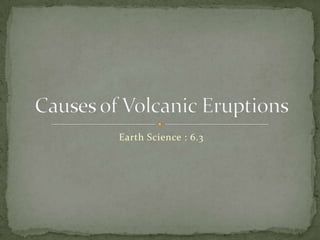Earth Science 6.3 : Causes of Volcanic Eruptions
•Descargar como PPTX, PDF•
5 recomendaciones•5,980 vistas
Denunciar
Compartir
Denunciar
Compartir

Recomendados
Recomendados
Más contenido relacionado
La actualidad más candente
La actualidad más candente (20)
Destacado
Destacado (20)
Similar a Earth Science 6.3 : Causes of Volcanic Eruptions
Similar a Earth Science 6.3 : Causes of Volcanic Eruptions (20)
Más de Chris Foltz
Más de Chris Foltz (20)
Último
https://app.box.com/s/7hlvjxjalkrik7fb082xx3jk7xd7liz3TỔNG ÔN TẬP THI VÀO LỚP 10 MÔN TIẾNG ANH NĂM HỌC 2023 - 2024 CÓ ĐÁP ÁN (NGỮ Â...

TỔNG ÔN TẬP THI VÀO LỚP 10 MÔN TIẾNG ANH NĂM HỌC 2023 - 2024 CÓ ĐÁP ÁN (NGỮ Â...Nguyen Thanh Tu Collection
Mehran University Newsletter is a Quarterly Publication from Public Relations OfficeMehran University Newsletter Vol-X, Issue-I, 2024

Mehran University Newsletter Vol-X, Issue-I, 2024Mehran University of Engineering & Technology, Jamshoro
Último (20)
TỔNG ÔN TẬP THI VÀO LỚP 10 MÔN TIẾNG ANH NĂM HỌC 2023 - 2024 CÓ ĐÁP ÁN (NGỮ Â...

TỔNG ÔN TẬP THI VÀO LỚP 10 MÔN TIẾNG ANH NĂM HỌC 2023 - 2024 CÓ ĐÁP ÁN (NGỮ Â...
UGC NET Paper 1 Mathematical Reasoning & Aptitude.pdf

UGC NET Paper 1 Mathematical Reasoning & Aptitude.pdf
ICT Role in 21st Century Education & its Challenges.pptx

ICT Role in 21st Century Education & its Challenges.pptx
Interdisciplinary_Insights_Data_Collection_Methods.pptx

Interdisciplinary_Insights_Data_Collection_Methods.pptx
Salient Features of India constitution especially power and functions

Salient Features of India constitution especially power and functions
General Principles of Intellectual Property: Concepts of Intellectual Proper...

General Principles of Intellectual Property: Concepts of Intellectual Proper...
Food safety_Challenges food safety laboratories_.pdf

Food safety_Challenges food safety laboratories_.pdf
Basic Civil Engineering first year Notes- Chapter 4 Building.pptx

Basic Civil Engineering first year Notes- Chapter 4 Building.pptx
Beyond_Borders_Understanding_Anime_and_Manga_Fandom_A_Comprehensive_Audience_...

Beyond_Borders_Understanding_Anime_and_Manga_Fandom_A_Comprehensive_Audience_...
Kodo Millet PPT made by Ghanshyam bairwa college of Agriculture kumher bhara...

Kodo Millet PPT made by Ghanshyam bairwa college of Agriculture kumher bhara...
HMCS Vancouver Pre-Deployment Brief - May 2024 (Web Version).pptx

HMCS Vancouver Pre-Deployment Brief - May 2024 (Web Version).pptx
Earth Science 6.3 : Causes of Volcanic Eruptions
- 1. Earth Science : 6.3 Causes of Volcanic Eruptions
- 2. Objectives: Describe the formation and movement of magma. Explain the relationship between volcanoes and plate tectonics. Summarize the methods scientists use to predict volcanic eruptions.
- 3. The Formation of Magma Understanding how magma forms helps explain why volcanoes erupt. Magma forms in the deeper regions of the Earth’s crust and in the uppermost layers of the mantle. Pressure and temperature aid in the formation of magma, and magma is formed in the mantle. *Temperature - fairly constant, so decrease in pressure is most common cause of magma formation.
- 4. Where Volcanoes Form The locations of volcanoes give clues about how volcanoes form. The map below shows the location of some of the worlds most active volcanoes.
- 5. When Tectonic Plates Separate At a divergent boundary, tectonic plates move away from each other, forming a set of deep cracks called a rift zone between the plates. Mantle rock rises to fill the gap opened by the separating tectonic plates. When mantle rock nears the surface, Pressure decreases, which causes the mantle rock to melt and form magma.
- 7. Mid-Ocean Ridges Form at Divergent Boundaries Lava that flows from undersea rift zones produces volcanoes and mountain chains called mid-ocean ridges. At these mid-ocean ridges, lava flows out and creates new crust. Most volcanic activity on Earth occurs at mid-ocean ridges.
- 8. When Tectonic Plates Collide Convergent boundaries Places where tectonic plates collide. Subduction Process when an oceanic plate collides with a continental plate, the oceanic plate usually slides underneath the continental plate. Subduction Produces Magma As descending oceanic crust scrapes past the continental crust, the temperature and pressure increase. Magma produced by subduction can rise to form a volcano.
- 9. Hot Spots Not all magma develops along tectonic plates boundaries. Hot spots volcanically active places on the Earth’s surface that are far from plate boundaries. Some scientists think that hot spots are directly above columns of rising magma, called mantle plumes. A hot spot often produces a chain of volcanoes. One theory is that the mantle plume stays in the same spot while the tectonic plates move over it. Other scientists think that hot spots are the result of cracks in the Earth’s crust. The theory argues that hot-spot volcanoes occur in chains because they form along the cracks in the Earth’s crust.
- 11. Predicting Volcanic Eruptions Volcanoes are classified in three categories: Active Volcanoes Dormant Volcanoes Extinct Volcanoes
- 12. Measuring Small Quakes and Volcanic Gases Most active volcanoes produce small earthquakes as the magma within them moves upward and causes the surrounding rock to shift. Just before an eruption, the number and intensity of the earthquakes increase. Monitoring these quakes is one way to predict an eruption. Studying the ratio of certain gases in a volcano also may help predict eruptions.
- 13. Measuring Slope and Temperature As magma moves upward prior to an eruption, it can cause the Earth’s surface to swell, and the side of a volcano may even bulge. Scientists can use instruments and satellite technology to detect changes in a volcano’s slope. Infrared satellite images record changes in surface temperature and gas emissions of a volcano to watch if the magma below is rising.